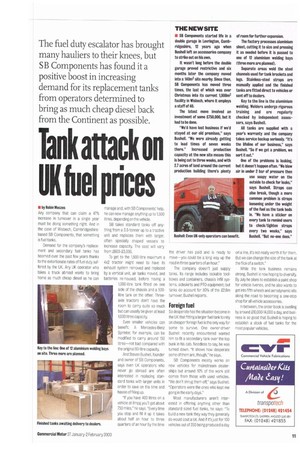Tank attack on UK fuel prices
Page 13

If you've noticed an error in this article please click here to report it so we can fix it.
U by Robin Meczes
Any company that can claim a 47% increase in turnover in a single year must be doing something right. And in the case of Wisbech, Cambridgeshirebased SB Components, that something is fuel tanks.
Demand for the company's replacement and secondary fuel tanks has boomed over the past few years thanks to the extortionate rates of fuel duty suffered by the UK. Any UK operator who takes a truck abroad wants to bring home as much cheap diesel as he can manage and, with SB Components' help, he can now manage anything up to1,500 litres, depending on the vehicle.
SB takes standard tanks off anything from a 3.5-tonner up to a tractive unit and replaces them with larger, often specially shaped vessels to increase capacity. The cost will vary from £600-23.000.
To get to the 1,500-litre maximum a 4x2 tractor might need to have its exhaust system removed and replaced by a vertical unit, air tanks moved, and batteries re-housed, before having a 1,000-litre tank fitted on one side of the chassis and a 500litre tank on the other. Threeaxle tractors don't have the room to carry quite so much but can usually be given at least 1,000 litres capacity.
Even smaller vehicles can benefit. A Mercedes-Benz Sprinter, for example, can be modified to carry around 150 litres—not bad compared with the original 80-litre capacity.
And Steven Bushell, founder and owner of SB Components, says even UK operators who never go abroad are often interested in replacing standard tanks with larger units in order to save on the time and hassle of filling up.
"If you have 400 litres on a vehicle at 8mpg you'll get about 750 miles," he says. "Every time you stop and fill it up it takes about half an hour to three quarters of an hour by the time the driver has paid and is ready to move—you could be a long way up the road in three quarters of an hour."
The company doesn't just supply tanks. Its range includes lockable toolboxes and containers, chassis infill systems, sideskirts and PTO equipment; but tanks do account for 80% of the £2.6m turnover, Bushell reports.
Foreign fuel
So desperate has the situation become in the UK that fitting a larger fuel tank to rely on cheaper foreign fuel is the only way for some to survive. One owner-driver Bushell recently encountered wanted him to fit a secondary tank over the top bunk in his cab. Needless to say, he was turned down. "It shows how desperate some of them are, though," he says.
SB Components mostly works on new vehicles for mainstream dealerships but around 10% of the work still comes from those with used vehicles. "We don't shrug them off," says Bushell. "Operators were the ones who kept me going in the early days."
Most manufacturers aren't interested in offering anything other than standard sized fuel tanks, he says: "To build a new tank they way they generally do would cost a lot. And if it's just for 100 vehicles out of 350 being produced a day on a line, it's not really worth it for them. But we can change the size of the tank at the flick of a switch."
While the tank business remains strong, Bushell is now hoping to diversify. By July he plans to establish a paint shop for vehicle liveries, and he also wants to get into fifth wheels and aerodynamic kits along the road to becoming a one-stop shop for all vehicle accessories.
In between, the order book is swelling by around 210,000-14,000 a day, and business is so good that Bushell is hoping to establish a stock of fuel tanks for the most popular vehicles.












































































































